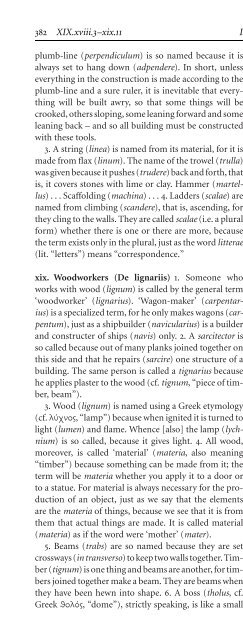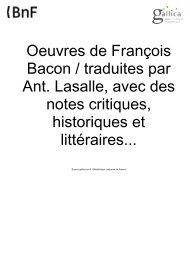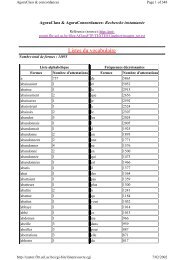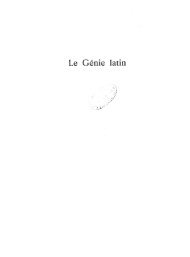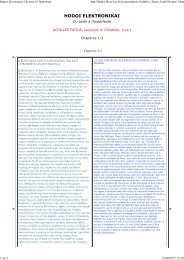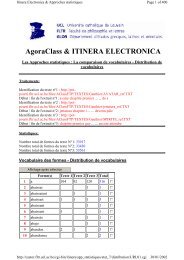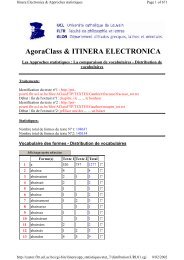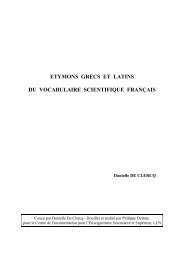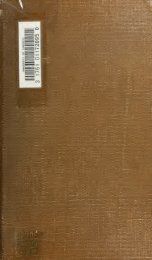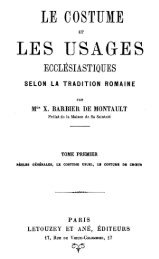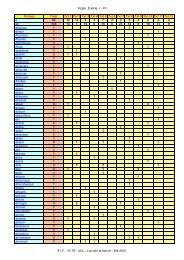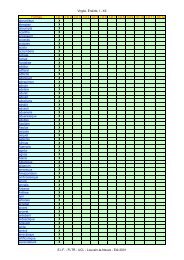The Etymologies of Isidore of Seville - Pot-pourri
The Etymologies of Isidore of Seville - Pot-pourri
The Etymologies of Isidore of Seville - Pot-pourri
Create successful ePaper yourself
Turn your PDF publications into a flip-book with our unique Google optimized e-Paper software.
382 XIX.xviii.3–xix.11 <strong>Isidore</strong> <strong>of</strong> <strong>Seville</strong><br />
plumb-line (perpendiculum) issonamed because it is<br />
always set to hang down (adpendere). In short, unless<br />
everything in the construction is made according to the<br />
plumb-line and a sure ruler, it is inevitable that everything<br />
will be built awry, so that some things will be<br />
crooked, others sloping, some leaning forward and some<br />
leaning back – and so all building must be constructed<br />
with these tools.<br />
3.Astring (linea)isnamed from its material, for it is<br />
made from flax (linum). <strong>The</strong> name <strong>of</strong> the trowel (trulla)<br />
was given because it pushes (trudere)backandforth, that<br />
is, it covers stones with lime or clay. Hammer (martellus)...Scaffolding(machina)...4.Ladders<br />
(scalae)are<br />
named from climbing (scandere), that is, ascending, for<br />
they cling to the walls. <strong>The</strong>y are called scalae (i.e. a plural<br />
form) whether there is one or there are more, because<br />
the term exists only in the plural, just as the word litterae<br />
(lit. “letters”) means “correspondence.”<br />
xix. Woodworkers (De lignariis) 1. Someone who<br />
works with wood (lignum) iscalled by the general term<br />
‘woodworker’ (lignarius). ‘Wagon-maker’ (carpentarius)isaspecializedterm,for<br />
he only makes wagons (carpentum),<br />
just as a shipbuilder (navicularius)isabuilder<br />
and constructer <strong>of</strong> ships (navis) only.2. Asarcitector is<br />
so called because out <strong>of</strong> many planks joined together on<br />
this side and that he repairs (sarcire) onestructure<strong>of</strong>a<br />
building. <strong>The</strong> same person is called a tignarius because<br />
he applies plaster to the wood (cf. tignum,“piece <strong>of</strong> timber,<br />
beam”).<br />
3.Wood (lignum)isnamedusing a Greek etymology<br />
(cf. ,“lamp”) because when ignited it is turned to<br />
light (lumen) and flame. Whence [also] the lamp (lychnium)<br />
issocalled, because it gives light. 4. Allwood,<br />
moreover, is called ‘material’ (materia, also meaning<br />
“timber”) because something can be made from it; the<br />
term will be materia whether you apply it to a door or<br />
toastatue. For material is always necessary for the production<br />
<strong>of</strong> an object, just as we say that the elements<br />
are the materia <strong>of</strong> things, because we see that it is from<br />
them that actual things are made. It is called material<br />
(materia)asifthewordwere ‘mother’ (mater).<br />
5. Beams (trabs) are so named because they are set<br />
crossways (in transverso)tokeeptwowallstogether.Timber<br />
(tignum)isone thing and beams are another, for timbers<br />
joined together make a beam. <strong>The</strong>y are beams when<br />
they have been hewn into shape. 6. Aboss(tholus, cf.<br />
Greek , “dome”), strictly speaking, is like a small<br />
shield. It is in the center <strong>of</strong> the ro<strong>of</strong>, and the beams come<br />
together in it. <strong>The</strong> tie-beams (coplae, i.e. copulae, lit.<br />
“joinings”) are so named because they join (copulare)<br />
the cross-beams to each other. Cross-beams (luctans)<br />
are so called because when set up they hold themselves<br />
against each other in the manner <strong>of</strong> wrestlers (luctans).<br />
Agrantes ...7. Posts (asser) are named from ‘singleness’<br />
(as)because they are set up by themselves and not<br />
joined.<br />
Shingles (scindula), because they are split (scindere),<br />
that is, divided. Pegs (epigrus) and nails are items with<br />
which wood is joined to wood. Nails (clavus) areso<br />
named as if the word were calibus,because they are made<br />
from calibs (i.e. chalybs), that is, iron, for chalyps is iron.<br />
8.Boards(tabula)werecalled tagulae by the ancients, as<br />
if from ‘covering’ (tegere), whence also ‘ro<strong>of</strong>-tiles’ (tegulae).<br />
A joining <strong>of</strong> boards is called a joint (commissura).<br />
<strong>The</strong> ‘action <strong>of</strong> cutting’ (sectio) isnamed from ‘following’<br />
(sequi,ppl. secutus) those things it has begun, for ‘to<br />
cut’ (secare) isto‘pursue’(sectare) and‘follow’ (sequi).<br />
9. <strong>The</strong> name for saw (serra) was formed from a sound,<br />
that is, from its ‘scraping noise’ (stridor). <strong>The</strong> use <strong>of</strong> saws<br />
and compasses was invented by Perdix, a certain youth<br />
whom Daedalus, his mother’s brother, had taken in as<br />
aboy to instruct in his studies. It is reported that this<br />
boy had such genius that, when he sought a quick way to<br />
divide wood, he copied the spine <strong>of</strong> a fish, sharpening a<br />
strip <strong>of</strong> iron and arming it with the biting power <strong>of</strong> teeth.<br />
Workmen name this the saw. <strong>The</strong> invention <strong>of</strong> this art<br />
drove his teacher Daedalus green with envy, and he threw<br />
the boy headlong from the citadel. <strong>The</strong>reupon Daedalus<br />
went to Crete as an exile and was there for some time, as<br />
stories relate. From Crete he flew, using wings, and came<br />
to Cilicia. 10.<strong>The</strong> compass (circinus)isnamed because it<br />
makes a circle (circulus)whenitisturned.This technique<br />
is carried out with a doubled string, which when single<br />
(i.e. undoubled) had been stretched across the width<br />
(i.e. the diameter desired). <strong>The</strong> point in the middle <strong>of</strong><br />
the compass (i.e. <strong>of</strong> the circle) is called the center (centrum,i.e.<br />
)bytheGreeks–everything converges<br />
on this middle point.<br />
11. <strong>The</strong>ax (securis) issonamed because trees are cut<br />
down (succidere) with it, as if the word were succuris.<br />
Again, it is called securis as if it were semicuris, for it is<br />
sharp on one side and suited for digging on the other. 11<br />
11 <strong>The</strong> allusion may be to curis,akind <strong>of</strong> spear: a semi-curis might<br />
be a blade sharpened on only one <strong>of</strong> its two edges.


